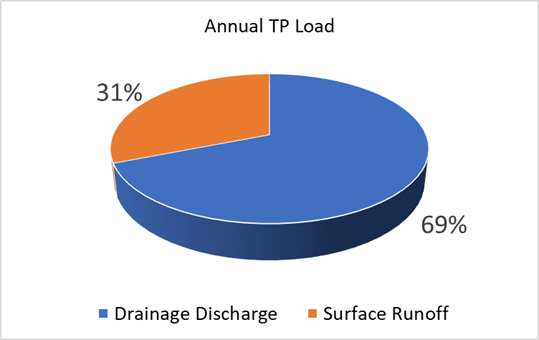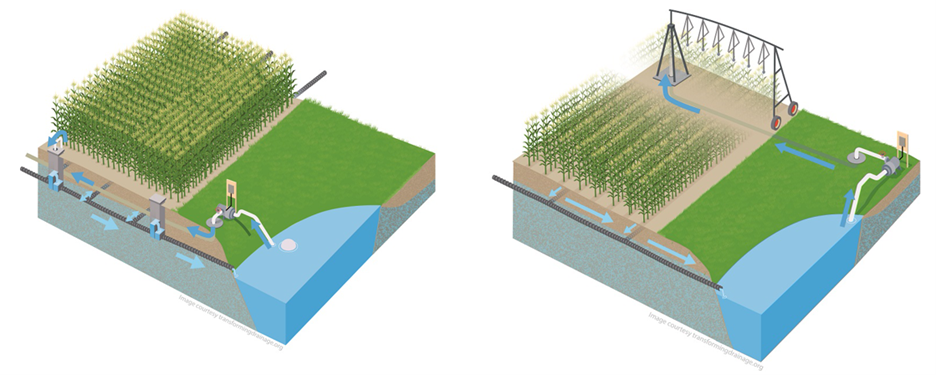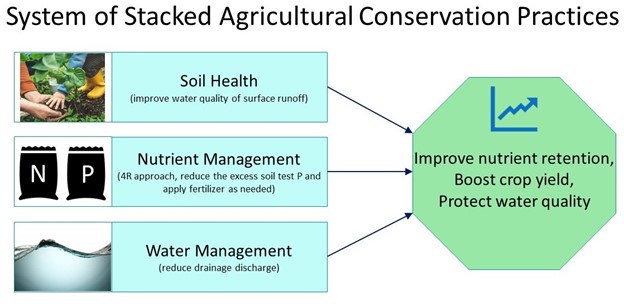Stacked practices: The key to phosphorus loss reduction
Soil health alone will not achieve our water quality goal. Nutrient management is a good start, but it's best when combined with water management to achieve our water quality goal.

There are various sources of phosphorus (P) entering Lake Erie, but agriculture is a dominant source. While subsurface drainage is critical for crop production, it can transport P to downstream water bodies. In subsurface-drained farms, P is mainly lost from two pathways - surface runoff and drainage discharge (Figure 1). Surface runoff mainly moves particulate P (soil-attached P) and drainage discharge mainly moves soluble P. When too much soluble P enters surface water bodies like Lake Erie and Saginaw Bay, it causes algal blooms.
Out of the two P loss pathways, drainage discharge, has been shown to be the major pathway, according to King et al. 2015. The Ohio edge-of-field sites showed that overall, 69% of Total P was lost via drainage discharge and only 31% was lost via surface runoff annually, according to Pease et al. 2018. Therefore, we need to focus on the major P loss pathway of drainage discharge as well as the secondary P loss pathway of surface runoff to achieve our water quality goal of 40% P load reduction into Lake Erie.

Soil health practices improve water quality of surface runoff
Soil health practices (minimum or no soil disturbance, permanent cover crop, and diverse crop rotation) have many benefits including building soil organic matter, increasing biological activity and improving soil structure. The better soil structure increases infiltration and leads to a better performing subsurface tile drainage system, thereby reducing surface runoff. However, surface runoff accounts for a smaller portion of the Total P loss into Lake Erie compared to the 69% share of drainage discharge, according to Pease et al. 2018. Therefore, improving water quality of surface runoff with soil health practices alone will not achieve our water quality goal.
While soil health practices improve water quality of surface runoff, certain practices may pose trade-offs when it comes to water quality of drainage discharge. No-till practices have been shown to increase the risk of P loss in drainage discharge in fine-textured clay soils when fertilizer is surface broadcasted, according to Jarvie et al. 2017 and King et al. 2015. No-till and cover crops alone will not achieve our water quality goal due to their increased risk of P loss in drainage discharge when fertilizer is surface broadcasted, according to Macrae et al. 2023 and Mott et al. 2025. Therefore, while we encourage the adoption of soil health practices for their many other benefits, they alone will not achieve our water quality goal in all subsurface-drained farms.
Nutrient management is a good start to achieve our water quality goal
The 4R nutrient management approach (right source, right rate, right time and right place) is important for reducing P loss in drainage discharge. Lowering the soil test P from high levels to reasonable agronomic levels improves water quality of drainage discharge (see tri-state fertilizer recommendation), but P can still be lost in drainage discharge even at reasonable soil test P levels. Therefore, while lowering the soil test P to reasonable agronomic levels is a good start, it alone may not be enough to achieve our water quality goal of reducing P loss in all subsurface-drained farms, according to Macrae et al. 2023. Therefore, it's best to combine nutrient and water management practices to achieve our water quality goals.
Water management is needed to achieve our water quality goal
Implement water management practices to reduce the drainage discharge leaving the field, thereby reducing the soluble P loss. Controlled drainage and saturated buffers are water management practices that reduce drainage discharge by managing the outlet pipe of the drainage system. When water removal is needed for spring planting and fall harvest, these two practices allow for temporary free drainage to provide field trafficability.
Saturated buffers are already equipped with a buffer strip, and similarly, controlled drainage should incorporate this feature. We should integrate controlled drainage with a buffer strip to reduce the risk of surface runoff.
Drainage water recycling is another water management practice that reduces drainage discharge, thereby reducing soluble P loss. This practice is a climate-smart system of capturing, storing, and reusing drainage water for supplemental irrigation (Figure 3). Drainage water recycling requires farms that are already equipped with subsurface drainage. This practice can improve water quality by retaining nutrients in the reservoir and build crop yield resiliency with supplemental irrigation during drought periods, according to Hay et al. 2021.

Even with those conservation drainage practices, some of the water still reaches the ditch. That’s where two-stage ditches are useful because they have potential to reduce P loss from the stream flow. Two-stage ditches help lessen the erosive power of water, which, in turn, decreases erosion along the streambanks. This reduction in streambank erosion also leads to less P coming from eroding banks.
Take-home messages
While we encourage the adoption of soil health practices for their many benefits, they alone will not achieve our water quality goal. Nutrient management is a good start, but by itself may not be enough to achieve our water quality goal of reducing P loss in all subsurface-drained farms. By stacking soil health, nutrient management and water management practices, you can improve nutrient retention, boost crop production and concurrently improve water quality (Figure 3).
Reach out to your local Conservation District, MAEAP technician or NRCS office for guidance in tailoring a stacked strategy for your specific need.




 Print
Print Email
Email



